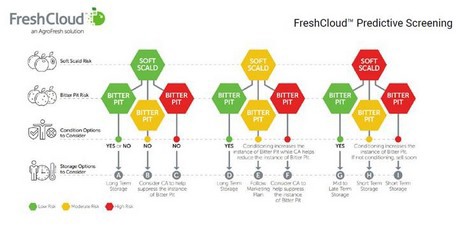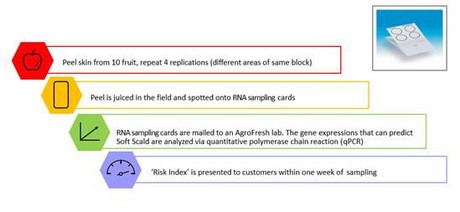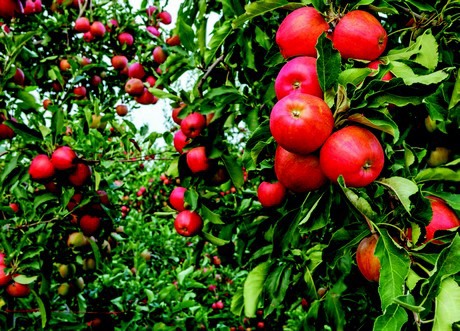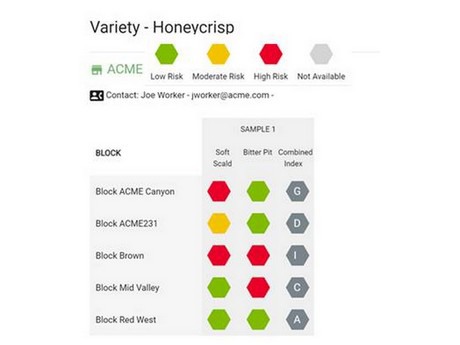Apple disorders can be extremely damaging to crops, and every year again growers lose parts of their harvest to disorders such as Soft Scald, Bitter Pit, and Internal Browning. These disorders materialize while the apples are in storage, but the crop’s risk for developing them can be determined around the time of harvest through the detection of specific biomarkers. This is what AgroFresh’s FreshCloud Predictive Screening provides and Brittany Buchanan, FreshCloud Global Business Lead, explains the process: “We look at the RNA Biomarkers of the fruit and assess the fruit’s gene expression. These markers are not inherited like genes are, but become visible through environmental influences of that specific season. We have identified the markers that are indicative of the likelihood that the Honey Crisp apples will develop Soft Scald or the Bitter Pit.”

Brittany says: “It takes us a minimum of three years to identify the various biomarkers and verify the accuracy of the tests. Last year we entered the market with the test for Soft Scald risk in the Honey Crisp and this year we added the Bitter Pit. We are also currently developing a test for Gala Internal Browning. We have identified the biomarkers, but there is still a lot of testing to be done. Gala apples are grown across the world, and so we have to validate the accuracy of our tests and see that these biomarkers respond the same in every region in which Gala are grown. In the coming years we will be able to add more varieties to our tests and the Gala Internal Browning test should be available within the next two years.”

To do the test, the growers or storage operators can either order their own sampling kit or pay to have someone from the company come out to their orchards to take the samples. Juice of the sample apples is mixed with an attraction buffer and then added to an RNA sampling card. This can then be read out by a QPCR machine to determine which markers are present. One sampling card uses 40 apples covering one orchard block.
“The orchard block can cover anywhere up to 10 acres of orchard, but some of our growers have 100-200 acres of the Honey Crisp trees. The growers have to choose which block and even which picking they want to test for. Sometimes they choose to test multiple pickings. These growers can pick up to five times, and often the first pick is put away for long-term storage because it is the highest quality fruit. This means that the growers are likely to be interested in knowing the risk factors for these apples. On the other hand, the later picks can be equally valuable because the risk levels of these pickings can determine whether the grower will store the apples or sell them more quickly.”

The Soft Scald and Bitter Pit tests combined, provide up to nine different outcomes and the company then helps the grower decide the best course of action on basis of the test outcomes. “We determine whether the risk factor for expressing the disorder is low, medium or high for both the Soft Scald and the bitter Pit. Conditioning the apples after picking decreases the expression of Soft Scald.
The risk for the Bitter Pit, on the other hand, is increased when Honeycrisp apples are conditioned. This is why it is really valuable to have a test that determines the crop’s risk for both Soft Scald and Bitter Pit. The outcome of the test will guide the growers’ decisions with regard to how they will store their product. We have developed a decision tree which helps growers and marketers think through their options based on their test results. Our accuracy is well over 80%, and there is a less than 4% chance that the growers are given a false negative” says Brittany.

Very early on AgroFresh researchers discovered that the Soft Scald Biomarkers respond in a diurnal manner, meaning apples used for sampling have to be picked between 6:00am and 11:00am. “The biomarkers are less visible at certain times or temperatures, so it is best to pick them when it is earlier and cooler. This also goes for the presence of the markers for the different disorders. The Bitter Pit and Soft Scald markers can be found close to harvest, so this means that the samples can be taken up to three days before the harvest. The markers for the Gala Internal Browning, however, appear much earlier and this test can be done one to two weeks before the harvest.”

The demand for these tests, which are sold commercially throughout North America, has been high. “This year we added the Bitter Pit test to the screening, and our volumes have more than doubled and the season isn’t over yet. It is very likely that our volumes will triple from last year before the end of this year’s season. Our company is focused on aiding growers in their success and this screening product helps growers prevent damaging disorders from taking hold of their crop. With continued research and development, we will be able to continue to add more tests for a larger variety of apples and disorders,” Brittany concludes.
For more information:
Brittany Buchanan
AgroFresh
https://www.agrofresh.com/contact-us/
